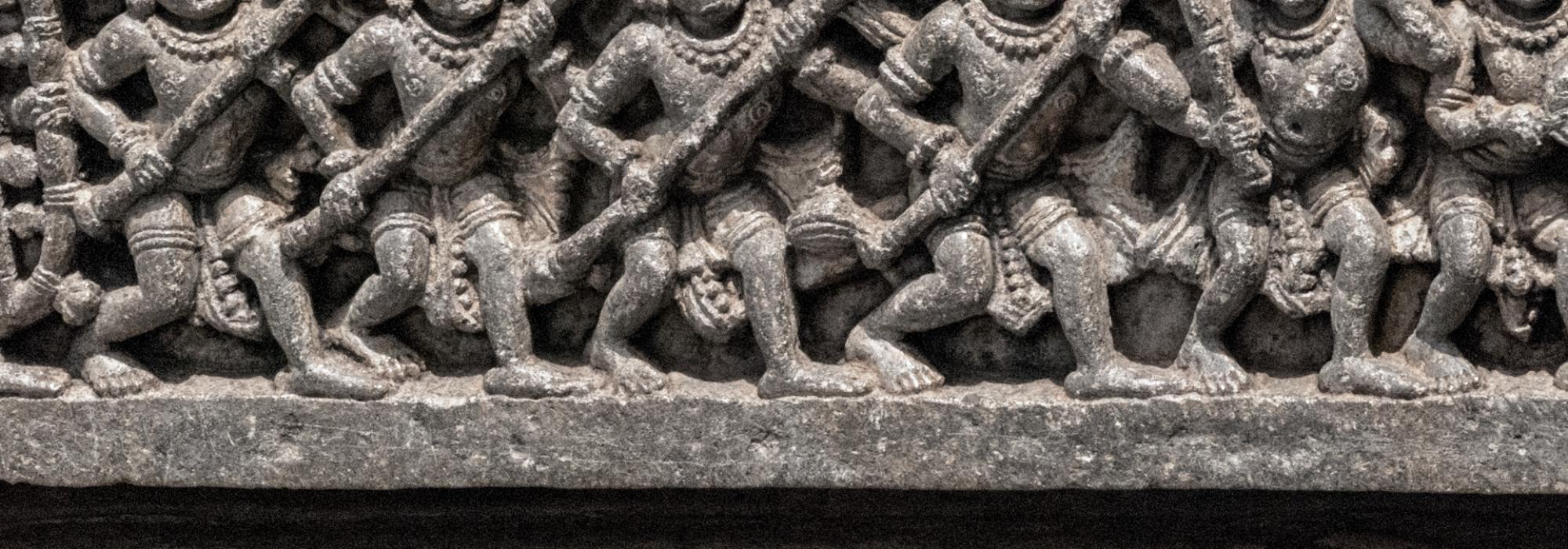The Kannada Sahitya Parishad appointed two senior scholars to carry out its work. One was Nanjundashastri of Togere. The other was Nanjundashastri of Kadaba. Both were eminent scholars.
Togere Nanjundashastri was appointed upon the recommendation of Mahāmahopādhyāya R Narasimhacharya. Nanjundashastri had worked under Narasimhacharya in the epigraphy department, studying inscriptions. Shastri knew all the well-known classical Kannada poems from memory. In addition, having examined thousands of Kannada inscriptions, he could recall from memory the usage of words in them. The sūtras of Pāṇini’s grammar and its numerous commentaries were in his active memory. By nature he was righteous and pure.
Once, in Kadur, the train we had to board had left by the time we reached. We had to wait there for twelve to fifteen hours. Shastri would not eat out. He took a bath and ate a few bananas and other fruits and answered my queries on grammar. The maxims laid down by [Keśirāja’s] Śabdamaṇidarpaṇa, the sūtras of Bhaṭṭākaḻaṅka that align with those rules, related rules given by the composer of the Bhāṣābhūṣaṇa [i.e. Nāgavarma], various usages in poetry, statements from inscriptions, and above all, Pāṇini’s opinion, and numerous examples – thus he lectured in a methodical manner, without a break, for two to three hours, thus advocating his siddhānta.[1] This is a fine example of traditional scholarship.
He was just as involved in giving lessons in poetry. He too was involved in the editing of the Pampabhāratha. His aesthetic sense[2] was evident during those discussions.
He wrote an essay on the history of the Kannada script. It was published not only in the newsletter of the Parishad but also as a booklet. He has shown the evolution of the present-day Kannada script from the Brāhmī script, giving detailed historical information along with examples from inscriptions.
Togere Shastri was simple by nature. He led a contented life with his meagre income. He was a bit short tempered. When it came to the śāstras, he was uncompromising.
If someone criticised Narasimhacharya’s writings as being difficult, Shastri would reply that such statements were made by people who were not scholars. He would say, “It is simply impossible for such scholars to write in a style that is simpler than the Nītimañjarī. For a scholar of the calibre of Narasimhacharya, this is a simple writing style.”
Togere Nanjundashastri was all skin, bones, and scholarship—he was a mix of these three. It did not appear like he had any flesh.
~
Once, a well-known person was bed-ridden due to paralysis. People who were close to him advised him to listen to the Purāṇas to overcome boredom. He had high regard for pundits and scholars. He called for me and requested me to arrange for a scholar to give a discourse on the Purāṇas. I suggested that Togere Nanjundashastri give a discourse on the Mahābhārata and also had it arranged. Accordingly, Shastri would go there by three in the afternoon; with the original text of the Mahābhārata in his hand, he would recite a verse in Sanskrit and then translate it into Kannada. This would go on till about five or five-thirty in the evening. Such was the arrangement. Shastri began the discourse with the Virāṭaparva.
After a few days, when friends of the bed-ridden man enquired about his health, he said, “It’s terribly boring; sleeping on one side all the time is painful.”
One of the friends asked, “What about the discourse?”
He replied, “What discourse! This sage came, that seer came. This pilgrimage spot, that sacred river. This is also boring!”
The friends agreed with him and said, “Yes, yes, that is a bore. Now, at your age, instead of listening to stories, it is more appropriate to listen to tattvopadeśa.[3] Why don’t you listen to the Bhagavad-Gītā?
After his friends left, he told our Shastri, “Good sir, I believe there are these Gītās—they tell me to listen to that. From tomorrow, let that begin.” Shastri said, “So be it” and began giving a discourse on the second chapter of the Bhagavad-Gītā. This continued for three or four days. On the fifth day, the bed-ridden man said, “What’s this—people seem to endlessly blabber these Gītās—what the hell is this farrago? Is it only about the control of the senses and self-regulation? It seems to be like a broken record, playing the same thing all the time.”
Nanjundashastri was enraged. Using a word like ‘blabber’ for the Gītā was, to his mind, a great crime. In that anger, he said in Telugu, “All this requires saṃskāras[4] from previous births. The vāsanas of your previous birth are not for this. What is acceptable for you is only the vāsanaof Chandravadana!”[5]
After saying this, he came to my house and placing the Gītā manuscript there, he said, “Tell him that this has ended.” Then he left. When I returned home at nine at night, I learnt about this episode.
The next morning I went to his house. He was performing his morning devārcanā.[6] The moment he saw me, he was reminded of the incident (which he had forgotten by then) and was enraged.
“What’s this sir? How could you send me to such a person?” he said and recounted the incident.
And I had to pacify him.
This is an English translation of the fourteenth chapter of D V Gundappa’s Jnapakachitrashaale – Vol. 3 – Sahityopasakaru. Edited by Hari Ravikumar.
Footnotes
[1] Siddhānta refers to the principle that is expounded in the end after presenting various arguments for and against a certain view.
[2] The original has ‘rasa-viveka.’
[3] A reference to ‘words of wisdom’ (tattva = philosophy; upadeśa = advice, counsel).
[4] Literally ‘culturing’ or ‘polishing.’ Here it refers to a certain refinement one obtains from birth.
[5] Shastri plays on the word ‘vāsana,’ which refers to ‘fragrance’ as well as ‘baggage from previous births.’
[6] Daily worship to the Supreme.














































